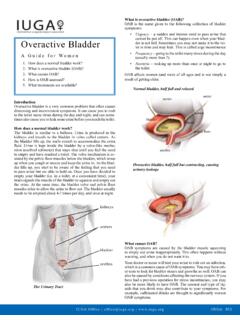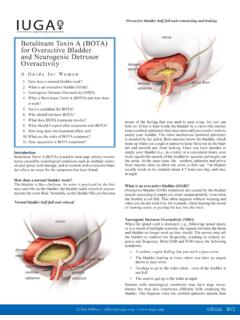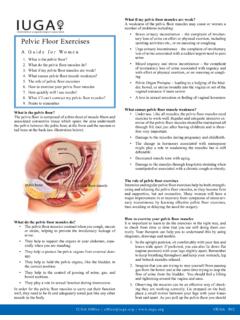Transcription of Anterior Vaginal Repair The surgery can be performed under ...
1 IUGA Office | | IUGA RV1 Anterior Vaginal Repair (Bladder Repair )A Guide for Women1. What is Anterior Repair ?2. Why is it performed ?3. How is the surgery performed ?4. What will happen to me after the operation?5. How successful is surgery ?6. Are there any complications?7. When can I return to my usual routine?IntroductionAbout 1 in 10 women who have had children require surgery for Vaginal prolapse. A prolapse of the front ( Anterior ) wall of the vagina is usually due to a weakness in the strong tissue layer (fascia) that divides the vagina from the bladder. This weakness may cause a feeling of fullness or dragging in the vagina or an uncomfortable bulge that extends beyond the Vaginal opening.
2 It may also cause difficulty passing urine with a slow or intermit-tent urine stream or symptoms of urinary urgency or frequency. Another name for an Anterior wall prolapse is a is Anterior Repair ?An Anterior Repair , also known as an Anterior colporrhaphy, is a surgical procedure to Repair or reinforce the fascial support layer between the bladder and the is the surgery performed ?The aim of surgery is to relieve the symptoms of Vaginal bulge and/or laxity and to improve bladder function without compro-mising sexual function. How is the surgery performed ?The surgery can be performed under general, regional or even local anesthetic.
3 Your doctor will discuss which is best for you. There are many ways to perform an Anterior Repair . Below is a general description of a common Repair method. An incision is made along the center of the front wall of the vagina starting near the Vaginal entrance and finish-ing near the top of the vagina. The Vaginal skin is then separated from the underlying supportive fascial layer. The weakened fascia is then re-paired using absorbable stitches, which will absorb over 4 weeks to 5 months depending on the type of stitch (su-ture) material used. Sometimes excessive Vaginal skin is removed. The vagi-nal skin is closed with absorbable sutures.
4 These usually take 4 to 6 weeks to fully absorb. Reinforcement material in the form of synthetic (perma-nent) mesh or biological (absorbable) mesh may be used to Repair the Anterior Vaginal wall. Mesh is usually reserved for cases of repeat surgery or severe prolapse. A cystoscopy may be performed to confirm that the ap-pearance inside the bladder is normal and that no injury to the bladder or ureters has occurred during surgery . A pack may be placed into the vagina and a catheter into the bladder at the end of surgery . If so, this is usually re-moved after 3-48 hours. The pack acts like a compression bandage to reduce Vaginal bleeding and bruising after su rge r y.
5 Commonly, Anterior Vaginal Repair surgery is combined with other surgery such as Vaginal hysterectomy, poste-rior Vaginal wall Repair or incontinence surgery . These procedures are covered in detail in other leaflets in this bodyuterusbladder Normal anatomy, no prolapse Anterior wall prolapsevaginarectumIUGA Office | | IUGA RV1 What will happen to me after the operation?When you wake up from the anesthetics you will have a drip to give you fluids and may have a catheter in your bladder. The surgeon may have placed a pack inside the vagina to reduce any bleeding into the tissues.
6 Both the pack and the catheter are usu-ally removed within 48 hours of the operation. It is normal to get a creamy discharge for 4 to 6 weeks after surgery . This is due to the presence of stitches in the vagina. As the stitches absorb the discharge will gradually reduce. If the discharge has an offen-sive odor contact your doctor. You may get some blood-stained discharge immediately after surgery or starting about a week after surgery . This blood is usually quite thin and old, brown-ish looking and is the result of the body breaking down blood trapped under the successful is the surgery ?Quoted success rates for Anterior Vaginal wall Repair are 70-90%.
7 There is a chance that the prolapse may come back in the future, or another part of the vagina may prolapse for which you need further there any complications?With any surgery there is always a small risk of complications. The following general complications can happen after any sur-gery: Anesthetic problems. With modern anesthetics and mon-itoring equipment, complications due to anesthesia are very rare. CBbladderAuterusuterusstitch Vaginal skin Bleeding. Serious bleeding requiring blood transfusion is unusual following Vaginal surgery (less than 1%). Post-operative infection. Although antibiotics are often given just before surgery and all attempts are made to keep surgery sterile, there is a small chance of developing an infection in the vagina or pelvis.
8 Bladder infections (cystitis) occur in about 6% of women after surgery and are more common if a catheter has been used. Symptoms include burning or stinging when pass-ing urine, urinary frequency, and sometimes blood in the urine. Cystitis is usually easily treated by a course of an-tibiotics. The following complications are more specifically related to an-terior Vaginal wall Repair : Constipation is a common post-operative problem and your doctor may prescribe laxatives for this. Try to main-tain a high fiber diet and drink plenty of fluids to help as well. Pain with intercourse (dyspareunia). Some women de-velop pain or discomfort with intercourse.
9 While every effort is made to prevent this from happening, it is some-times unavoidable. Some women also find intercourse is more comfortable after their prolapse is repaired. Damage to the bladder or ureters during surgery is an uncommon complication which can be repaired during su rge r y. bladderfasciavaginaB) repairing the fascial layerA) Anterior Vaginal wall prolapseC) repairing Vaginal skin layerIUGA Office | | IUGA RV1 The information contained in this brochure is intended to be used for educational purposes only. It is not intended to be used for the diagnosis or treatment of any specific medical condition, which should only be done by a qualified physician or other health care professional.
10 Incontinence. After a large Anterior Vaginal wall Repair some women develop stress urinary incontinence due to the unkinking of the urethra (tube from the bladder). This is usually simply resolved by placing a supportive sling under the urethra (see the leaflet on stress urinary incon-tinence). Mesh complications. If mesh is used for reinforcement there is a 5-10% risk of mesh extrusion requiring trim-ming as an office procedure or a brief return to theatre. Rarely, pain can develop associated with the mesh requir-ing part or all of the mesh to be can I return to my usual routine?In the early post-operative period you should avoid situations where excessive pressure is placed on the Repair , lifting, straining, vigorous exercise, coughing, and constipation.












